Cate La Farge Summers is a Nantucket native and Brooklyn-based writer and contributing editor for One Kings Lane. Get to know Cate in her monthly columns that run the gamut of decluttering her home Kondo style to learning how to make the perfect apple pie.
Late summer always finds me knee-deep in nostalgia. I grew up on Nantucket, an island 30 miles out in the Atlantic, and for those of us natives who’ve moved to the mainland—I’m now in Brooklyn with my own family—it’s easy to romanticize our childhoods. By late summer, I like to think I was deep in the swing of a barefoot existence—hair permanently salted by the ocean; living off bush-fulls of berries, fresh-caught fish and fresh-dug clams, and garden vegetables; spending days collecting shells and sea glass on the beach; gathering handfuls of wildflowers for the dinner table. There are less romantic slants, but that’s the one I chase when we come back.
There’s another thing I always search for when we come back—a certain aesthetic that, in my mind, is also native to Nantucket. The island houses I always loved most are grounded in the island’s natural layers: ocean, fog, low grassy landscapes, sea-smoothed shells. There’s an understatement, a Yankee sparseness to the way those houses are put together. Everything is made well, in the kind of good material that might weather a few generations: hand-loomed textiles in bare blues and clear whites; handwoven rattan baskets; ceramics in oceany glazes that have a pleasingly earthy weight; glass in foggy sea-glass greens; aged wood. While these things all carry a summertime ease, they can also be layered and cozied up in the winter or during a summer storm.
The island imports many things such as newspapers and gas and milk, but this meticulous kind of craftsmanship is often homegrown. And a lot of it carries the DNA of the Nantucket Looms, an arts-and-crafts studio founded in 1968. You can get name-droppy about The Looms, as it’s known—Princess Grace and Jackie Onassis each beelined there on visits to the island—but at its heart, it’s a weaving studio. The weavers still work above the shop, passing shuttles across alpaca blankets and light-as-air linen-cotton napkins.
My mom was one of those weavers in the late 1970s, a few years before my parents met on the island and decided to stay there. I think of my parents as part of a generation of thoughtful, slightly countercultural, hearty souls who planted themselves on the out-at-sea island and made a real life of it. I’m not one of them now, but I love keeping up with the many people who are continuing those island traditions of making beautiful things by hand or otherwise staying close to the elements. Or starting farms: According to Sustainable Nantucket, the number of farms on the island has more than tripled since 2007.
Before fall swept us back to New York this year, I wanted to find a way to capture this natural, lower-profile side of Nantucket: the summery comfort foods that reflect the local supply, the understated look and feel of island design, and the people who are making all of this happen in a fresh way. A dinner party—an open-house, outdoors, no-place-cards kind, in my childhood home—seemed like a doable way to conjure that all up, for a few hours at least.
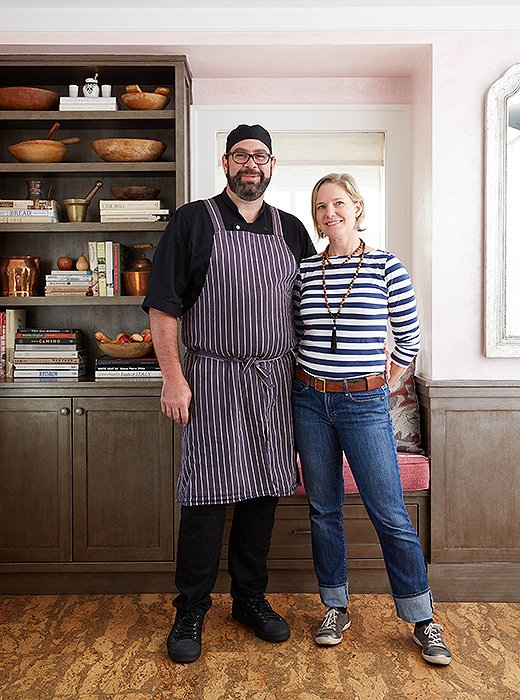
Joy and Greg Margolis, who together run the new-this-year Nantucket Culinary Center (she is its director, while Greg is the chef, or more formally, the culinary director). When I decided to throw my own Nantucket-style dinner party, they became my guides.

Even though I’m not one of them now, I love keeping up with the people who are continuing those island traditions of making beautiful things by hand, starting their own farms, or otherwise staying close to the elements.
Finding My People
To translate all these vague nostalgic cravings into a dinner party, I needed some on-the-ground help. For one thing, I still couldn’t confidently cook fish. Thankfully, earlier this year the Nantucket Culinary Center opened. A cooking school and café run by a local couple, Joy and Greg Margolis, it’s fast becoming the place to learn home cooking à la Nantucket. Even its aesthetic syncs with what I was after: The Culinary Center was designed stem to stern by The Looms.
Greg’s cooking classes also nailed what I was after. While he isn’t a native, Greg is a natural Nantucket chef. After formal culinary training elsewhere, he spent his formative cooking years on Nantucket working at the elegant Topper’s restaurant on the island’s eastern tip as well as at one of its great family-run farms, Moors End. He barely wastes a scrap while he’s cooking, which has become a more popular philosophy lately but which I’ll also claim as a Yankee value (my dad, who was an old-fashioned Yankee, went up in arms if anything was ever wasted). Greg’s flavors are pure with little pretense, and he is pitch-perfect when it comes to seasonality. His ingredients reflect Nantucket’s own bounty; as Joy says, “On the mainland, you can pretty much get anything anytime. Here, we try to base what we cook around what’s in the farm and in the waters.”
A little island fact: With no big-brand stores on the island and the need to import most everything, it becomes more compelling to make things yourself. I’d first met Joy through my mom—well before the Culinary Center opened, she and my mom struck up a friendship when they were both standing in line for coffee and my mom (now a reflexologist) admired Joy’s cashmere leggings. It turned out Joy had knit the leggings herself, and thus began a system of exchanging cashmere leggings for reflexology treatments: a luxurious example of the island’s healthy bartering economy.
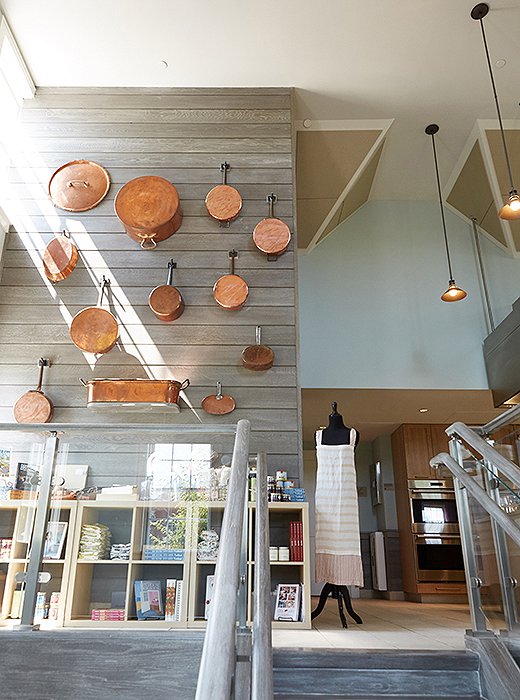
The Nantucket Looms chose a gray wash over reclaimed oak, along with a collection of antique and new copper pots, for the staircase leading up to the Culinary Center’s top floor, where many cooking classes are held.

On the mainland, you can pretty much get anything anytime. Here, we try to base what we cook around what’s in the farm and in the waters.
Getting in the Spirit of Island Cooking
Tucked into the shelves of many Nantucket kitchens you’ll find a sun-damaged copy of Sarah Leah Chase’s Open-House Cookbook, a defining cookbook for the warmer months on Nantucket. When we met in college, I discovered that my now-husband carried his own copy, even though he grew up in Savannah. I knew then that he was a kindred coastal spirit. Other bibles for Nantucket-style cooking include anything by Marian Morash, who helmed The Straight Wharf, a very favorite seafood restaurant, for more than a decade. Morash’s husband, Russ, keeps a vegetable garden to end all vegetable gardens in a hidden corner of the island. I make a soup from her Victory Garden Fish and Vegetable Cookbook whenever I’m homesick.
What Chase, Morash, and others take care to point out is the eclectic nature of Nantucket’s culinary influences. Yes, the island has a reputation for WASPy exclusivity, but slice into the home-cooked cuisine and it’s a mini melting pot. The island has collected people from far-flung locales for centuries now, and as a result, there are Caribbean spice and French haute cuisine alongside New England regional staples. There’s a strong legacy of Portuguese cuisine on the island because, when Nantucket was a whaling capital, the captains recruited some of the best whalers from the Azores, those Portuguese islands 2,000 miles farther into the Atlantic. Whaling is long over, but Portuguese bread stocks the shelves, and in the cold months, islanders bring out their recipes for Portuguese kale soup spiced with linguica. It keeps cuisine interesting and opens up the possibilities for an “authentic” island menu too.
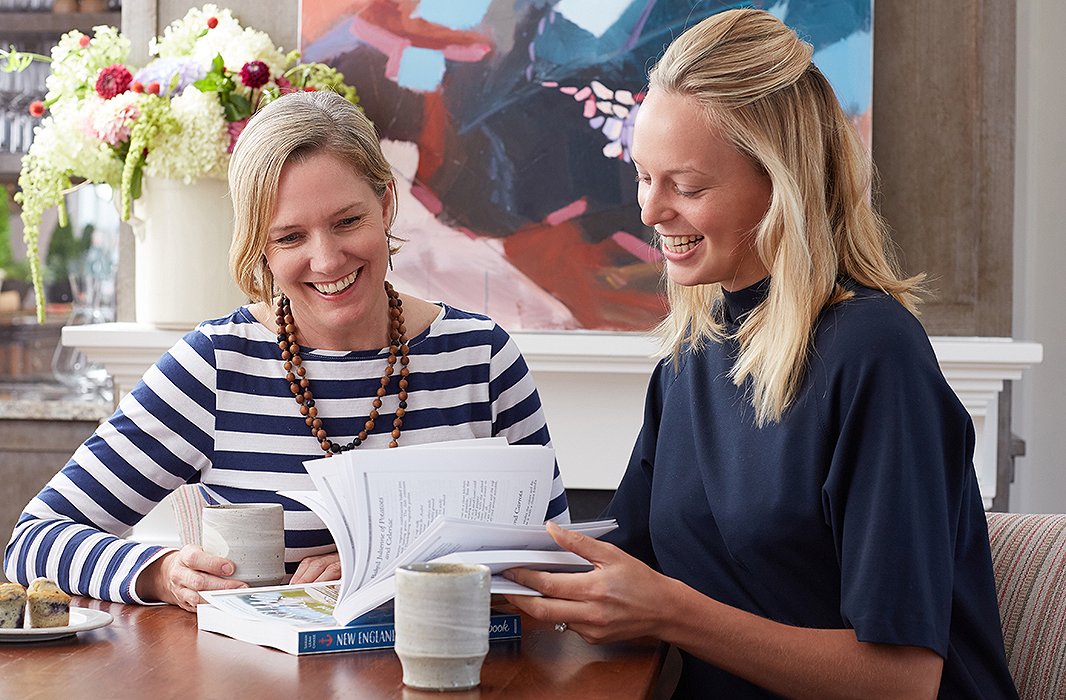
Joy and I page through our favorite recipes in Sarah Leah Chase’s Open-House Cookbook—her 1987 original and the updated version. Chase often drops by the Culinary Center to teach classes.
More on island cooking from chef Ned Claflin, with whom I grew up on Nantucket: “You don’t realize the flavors of a place until you are far away and start missing things.” After an impressive streak on the mainland from New York to New Orleans, Ned bought another island restaurant, Oran Mor, and resettled on Nantucket this spring to become its executive chef. Cooking here professionally has taught him the real ways that one is closer to the elements: “So much is affected by the humidity and the salty air. Baking is a different world out here. You can never get chocolate chip cookies anything but chewy. Why fight it? Go soft-baked cookie!”
Learning a Summer Repertoire
I wanted a new summer repertoire, standbys that I could lean on for years to come without thinking or working too hard. Specifically, I wanted to get the most out of summer vegetables and finally crack the code on fish. People often describe cooking fish as this supremely casual act—sprinkle on some salt and olive oil, pop into the oven, and voilà. Yet in the moment, especially if guests are arriving, I often question when it’s really done and whether its flavor has been overpowered by herbs. Or worse, whether it’s on the boring side. Good seafood is too pricey to waste on second-guessing.
With these rough perimeters, Greg and I landed on a menu that sounded like summer incarnate. It would start with a garden gazpacho garnished with herbs and crabmeat. Then striped bass, prepared using a cool Japanese technique that could be applied to many other fish if “stripers” aren’t in season, and served over a rustic bed of buttery corn and grape tomatoes. And a blueberry-basil syrup that can become a refreshing afternoon soda or a dressier evening cocktail. The syrup literally bottles up those summer flavors and will keep forever in the fridge. I thought about the fun of tasting a spoonful of blackberry jam in January and being transported back to those languid days of summer. A syrup that could be used for drinks or on pancakes might be even better.
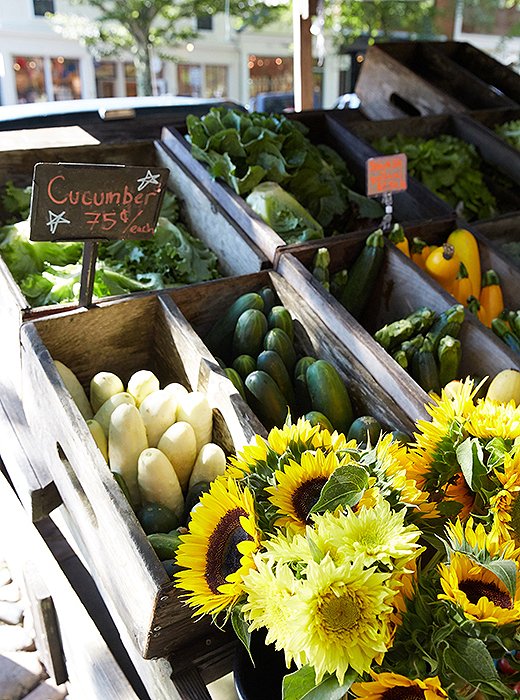
The Bartlett’s Farm food truck is an institution. Spot it parked on Main Street and get there before it sells out. Its heirloom tomatoes are legendarily juicy.
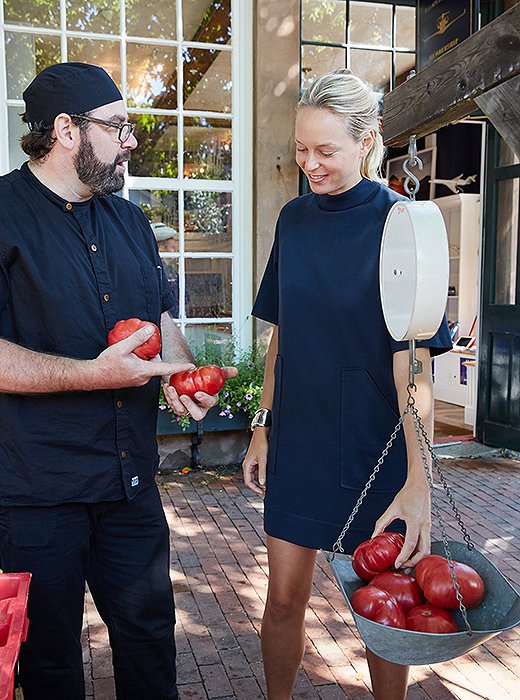
When you weigh for the amount of tomatoes you need, keep in mind that you’ll be carving out the core and, on heirlooms, any brown bits, so you’ll end up with a bit less than you take home.
A Lesson on Vegetable and Fish Shopping
For some of us, cooking confidence can start to waver when we shop for ingredients. Aren’t we supposed to pick through vegetables like the proverbial Frenchwoman, skilled at daily market shopping and with an inborn idea of exactly what you want out of each squash? Or arrive at the fish counter and speak with cheflike authority about what you need—do you ask for the bones removed? What if they don’t have the fish that your recipe asks for? On top of it all are the many environmental concerns swirling around various fish.
We addressed vegetables first, strolling to the Bartlett’s Farm produce truck, where Greg goes most summer mornings to get his gazpacho ingredients (he can’t keep it in stock). The peppers and cucumber and onions are all straightforward buys. For corn, Greg’s only comment was, “There’s nothing more annoying than the guy who goes around opening each ear of corn to check it out.” But tomatoes required a touch more nuance; for gazpacho, “you want bigger tomatoes, since they require less knife work,” Greg advises. Most of all, for tomatoes and any other farm-fresh vegetables, Greg encourages us to shop with an open mind. If you select only tomatoes with unblemished skin, for instance, the farmer is less likely to sell the rest and will be left to toss many, many tomatoes that are just as delicious but less attractive.
For the fish, his advice is to stay flexible. Rather than go in thinking it’s wild salmon or bust, have in mind the general type of fish you want—a firm-fleshed one such as striped bass or salmon, or a lean and flaky one such as flounder or rainbow trout. Buy it skin-on, but ask the fishmonger to take out the bones. With the skin, you’ll be keeping the flavor until you’re ready to cook.
And don’t offend the fishmonger by asking if his fish is fresh. Instead, eye it yourself: “The flesh of bass fillets should be white, firm, and sparkling, translucent rather than dull or opaque,” Marian Morash wrote of shopping for her favorite fish.

Greg stays on the right side of the hot-button issue around wasting “ugly” produce. We walked back with plenty of beautifully brown-speckled heirloom tomatoes.

Aren’t we supposed to pick through vegetables like the proverbial Frenchwoman, skilled at daily market shopping and with an inborn idea of exactly what you want out of each squash?

Greg’s gazpacho recipe, honed over perhaps thousands of gallons, hinges on two things: knife skills and a balance between puréed liquid and diced vegetables.
Finding Balance in Gazpacho
Greg’s passion for soup runs deep. He calls it “one of the last great peasant foods. It always makes everyone superhappy.” His gazpacho recipe might be the ultimate showcase for what he calls his “vegetable-centric” cooking style. For me, it might be the most satisfying, crave-able take on fresh vegetables. Light layers of spice and a garnish add some dimensionality, but the tomatoes, especially, stay in the spotlight.
In past summer trips to Nantucket, my husband and I tried to make gazpacho—the dream was to make it one morning and then have it for lunch several days running, without needing to lift an additional finger to cook or chop. But it often turned watery or never got that bright, crisp color and crunch to begin with, so we went back to tomato-and-Hellman’s sandwiches.
Greg believes the key to gazpacho is balance: There should be a nice equilibrium between the puréed liquid and the diced vegetables that give it texture and crunch. And he puts real emphasis on the dicing itself: “Think of the rule of thumb when making soup that, no matter how many ingredients you put in, you should be able to get all of them on your spoon at once.” With a sharp knife and a few dicing guidelines, you can get the diced pieces all the same shape and size—a quarter-inch cubed. The fun of this, for home cooks, is that it gives you plenty of practice to hone your own knife skills—all in a forgiving way, because for gazpacho, close enough will still taste wonderful.
See Greg’s full gazpacho recipe here—including knife advice and an easy crabmeat garnish.

Soup is one of the last great peasant foods. It always makes everyone superhappy.

Greg’s skin-on fillets of fresh striped bass, ready to be skinned and then cut into six-ounce portions (think of each portion as the size of a deck of cards).
Finally Conquering Fish
Greg’s recipe for striped bass resolves all my fish anxieties. He makes a dead-easy quick cure of equal parts salt and sugar, then tosses in chopped herbs (whatever you have around, and dried herbs are fine) along with lemon zest. All you do is coat the portioned pieces of fish, let them sit for 20 minutes, and then rinse. The fish’s own flavor will be brought out loud and clear, since that’s what salt and sugar do at their best. “Whether people admit it or not, salt and sugar are incredible flavor enhancers—like MSG but with a better reputation,” Greg says. “With herbs and citrus, this cure really accents the particular nature of the fish.”
Once the cure is rinsed off, Greg says, “the fish needs nothing. All you do is cook it.” The fish can be pan-seared and finished in the oven, or grilled. The cure makes it hold together through the cooking. Greg showed me a rustic corn-and-grape tomato base, which gives it a note of buttery corn on the cob. What could be better?
Check out the full recipe here.
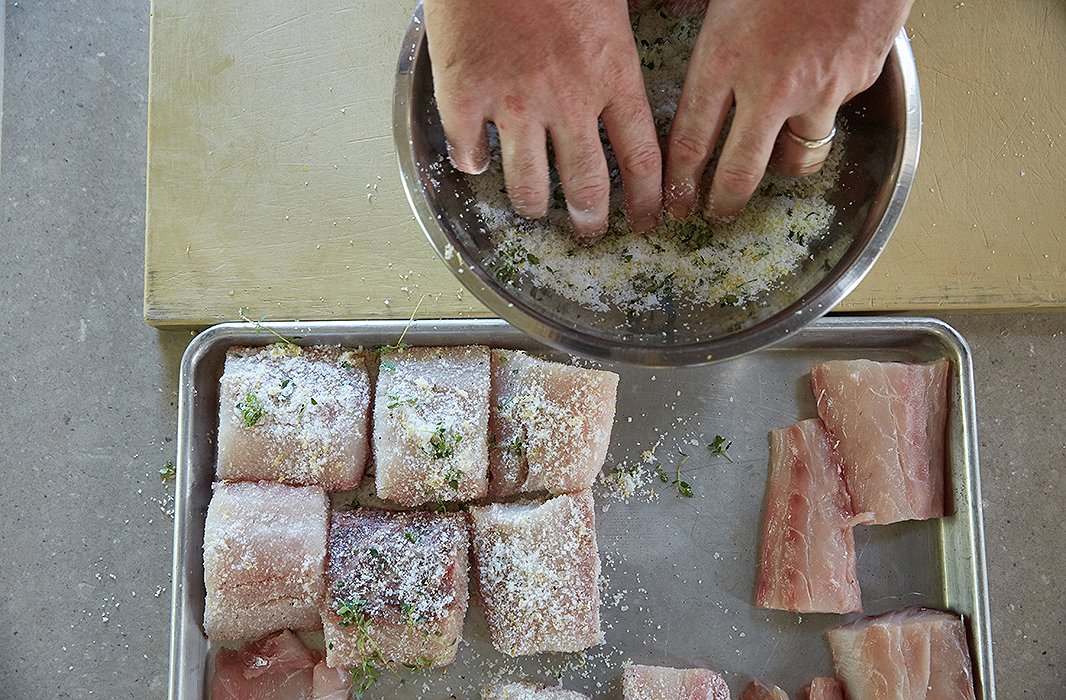
The surprise step in Greg’s recipes for cooking many types of fish: a quick cure, which is an age-old Japanese method that lets the flavors penetrate and makes the fish easier to cook. Get his full recipe for this striped bass here.
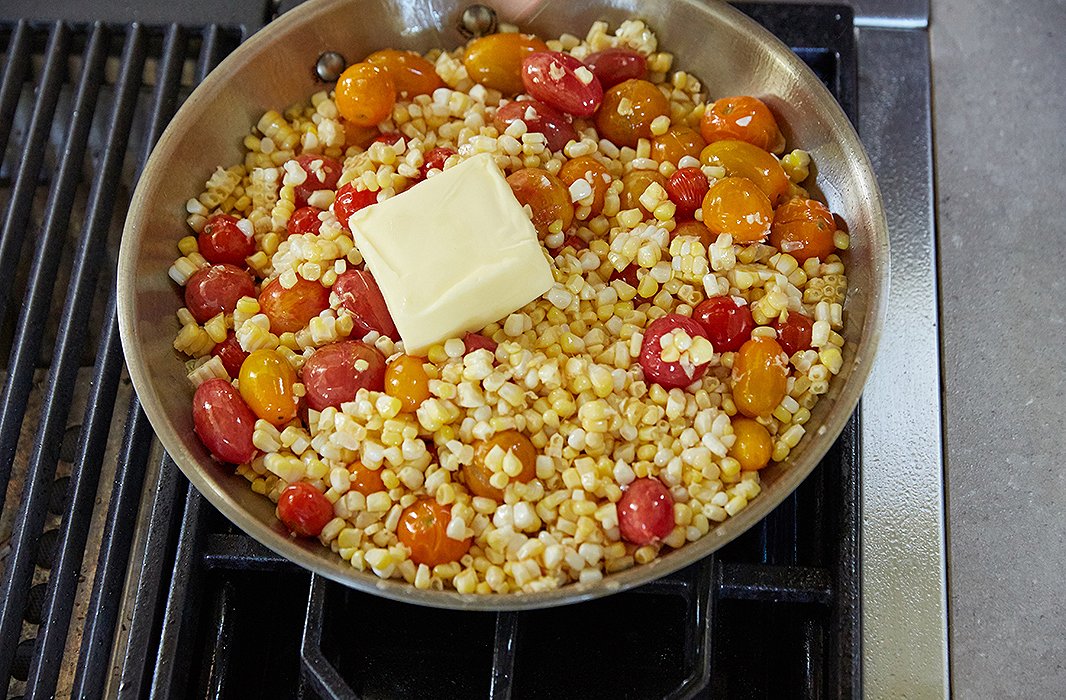
Destined to be the base for our fish: a rustic tomato-and-corn mishmash that delivers that very summery buttery corn-on-the-cob taste.
At-home tip: Sip something while you cook. We cooked in the morning, so Greg made us a lemon verbena and mint tea with a touch of agave (two bunches of each herb tossed into a cold pot of water; “when the water boils, the tea is done,” Greg says). But once the sun shadows are stretching long on the grass (or through your city window), it’s safe to switch to rosé. Greg says a bonus of sipping is that it creates a pause in your work. Things need time to heat up or to mix and melt, and even a tiny break keeps you from rushing and might remind you to taste as you go.
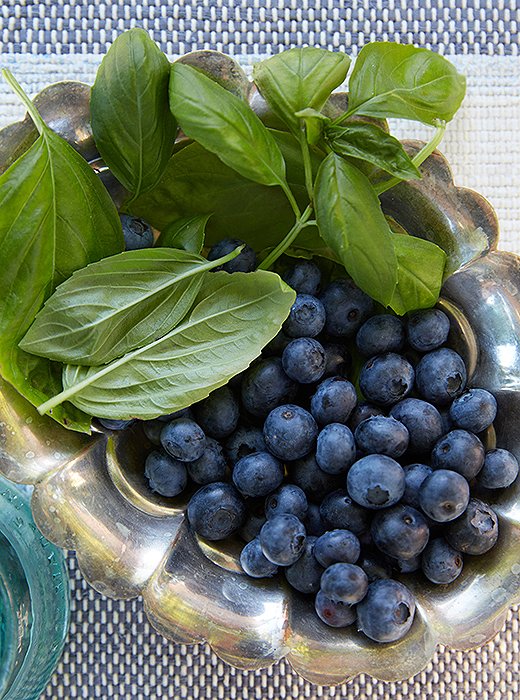
Once I got home, we got the syrup ready for cocktails. And I put out the two main ingredients in the syrup—basil and blueberries—for garnish.
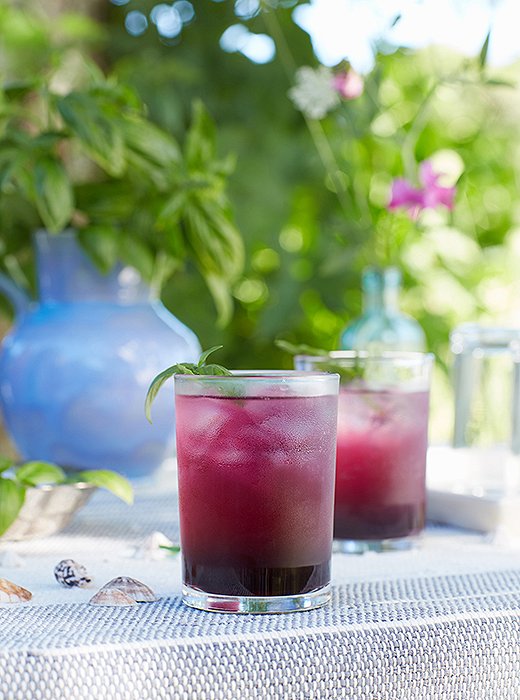
I’ve always been partial to Dark and Stormies in the summer, but this might be my new favorite: The dark beautiful blueberry color is full of allure, and the syrup goes with almost anything.
A Shortcut to Summer Flavor
When the berries were ripe each summer, my mom used to hand us a measuring cup and we’d head out to the blackberry bushes, or the blueberry bushes, or the huckleberry bushes. Once it was filled, we’d come back, and she’d throw together a berry tart. Or we’d fill more measuring cups and start an afternoon-long project of jam-making. Those wild berries are harder to come by now, but store-bought berries can bring that same whopping dose of happiness.
When we returned to the house, we put together Greg’s blueberry-basil syrup, which reminds me of jam-making—all that foaming fragrant juice on the stove—but takes a fraction of the time.
Note: Greg says the sugar-to-water ratio is the only fixed rule of this recipe (he tried to use less sugar, but the berries really need it); otherwise, it’s wide-open. Use lemon and thyme, or lemon and rosemary, to make a lemonade syrup. Or use strawberries and mint, or basil and plum.
Blueberry-Basil Syrup Cocktail
Serves 2-4
Ingredients
2 pints blueberries
1 big batch of basil
2 cups sugar
2 cups water (or substitute with champagne or vodka)
Combine all ingredients in a saucepan, and mash the berries a bit with a fork. Bring the mixture to boil, staying vigilant so it doesn’t boil over, then simmer for five minutes. Strain out the berries and the basil leaves. What you have left is a syrup, which will keep in the fridge through the winter.
When serving, play with proportions to find your preferred sweetness level. In a pint glass filled with ice, try adding two ounces of syrup and then filling the rest of the glass with sparkling water or champagne. For something stiffer, do two ounces syrup, two ounces vodka, and then top it off with sparkling water. Garnish with a few blueberries and a basil leaf.

Greg’s blueberry-basil syrup reminds me of jam-making—all that foaming fragrant juice on the stove—but takes a fraction of the time.
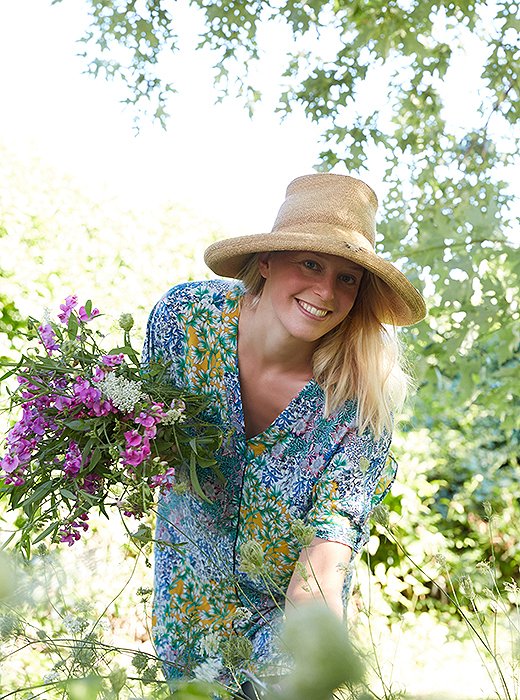
Cutting Queen Anne’s lace and sweet peas—two favorites—from my mom’s garden. Thankfully their season seems to stretch later on Nantucket than elsewhere on the East Coast.
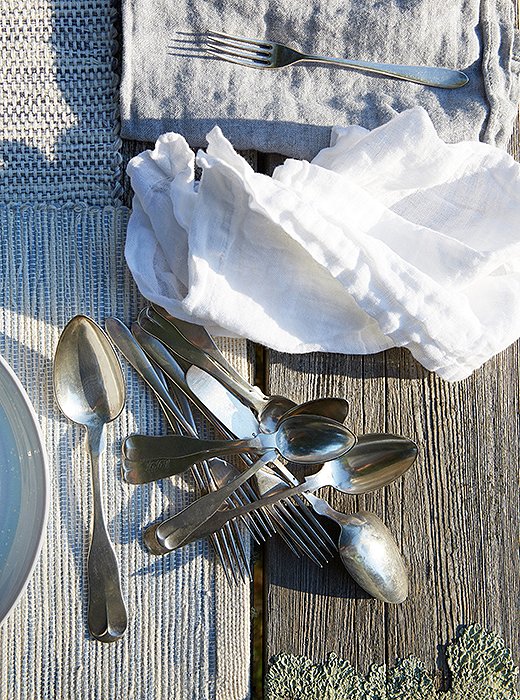
Our picnic table is covered in the pale-green lichen that takes up residence on shingles and porches all over the island. Again, why fight it? A gray-white runner and blue-gray place mats from the Nantucket Looms look just right on the weathered wood.
Bringing the Vision to Life
Does anyone else have the most fun setting the table? I couldn’t wait to start putting together the atmosphere that had been batting around my mind all summer. I’d mined the attic and my mom’s cabinets to find textiles and baskets that brought me to that vision of good island craftsmanship. I kept glassware simple so that the antique glass pieces would stand out, and used my great-grandmother’s big, comfortable silver spoons for the gazpacho. Then I added more and more flowers.
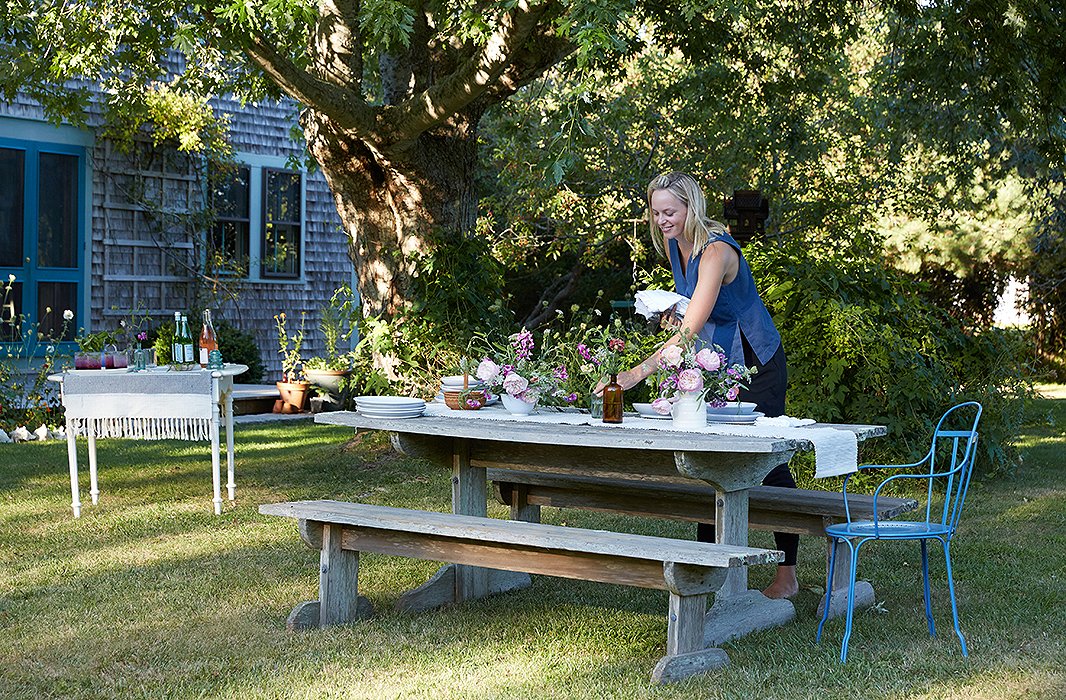
Andy Oates and Bill Euler, the men who’d founded the Nantucket Looms in the late 1960s, established what’s become known as Nantucket cottage style—a more official term for the style I was after. Their own “shack,” tucked into a far-off island beach, housed their collection of crafts and art. I ended up buying the white pitcher here from their estate.
I’d also collected a few more pieces to round out the look, including plates and bowls from Nell Van Vorst, with whom I also grew up on Nantucket. I remember Nell always crafting something outrageous—there was a long streak of crazy-beautiful origami when she was a teenager. Now her studio is chock-full of dreamy ceramics that she throws on a wheel, then glazes. If she adds decorative detail, it’s always something straight from Nantucket’s ecosystem—maybe flying terns or winterberries.
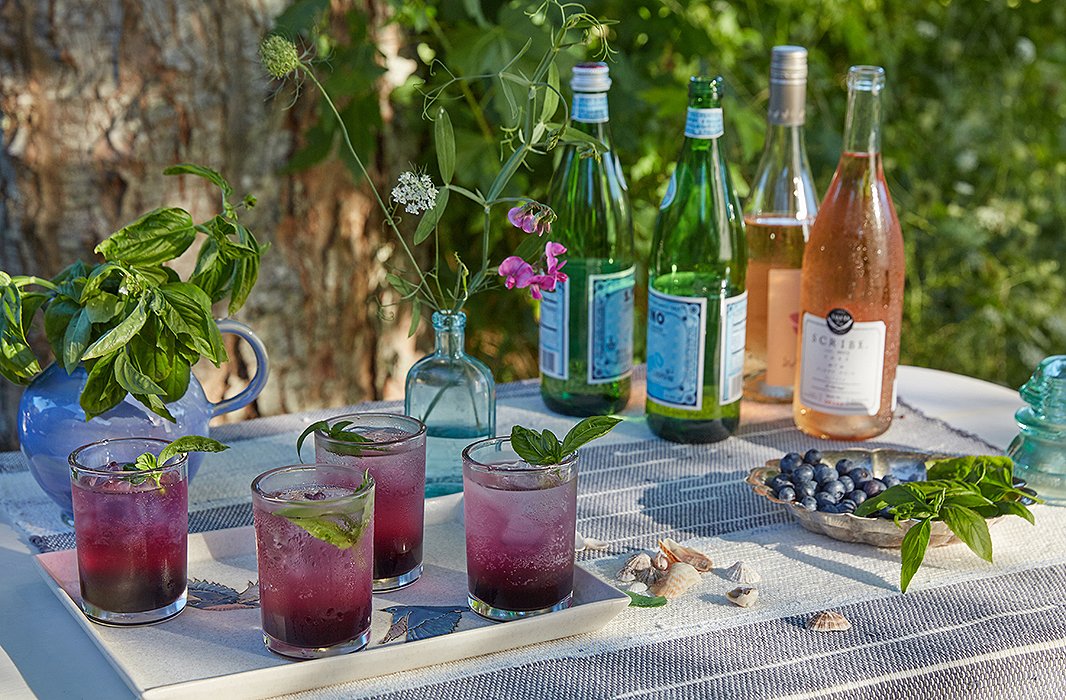
I used Nell Van Vorst’s flying bluebird plate for the drinks, along with her dreamy blue-glazed pitcher. Underneath I placed one of my mom’s own loomed designs, which I’d found in the attic.

I’d mined the attic and my mom’s cabinets to find textiles and baskets that brought me to that vision of good island craftsmanship.
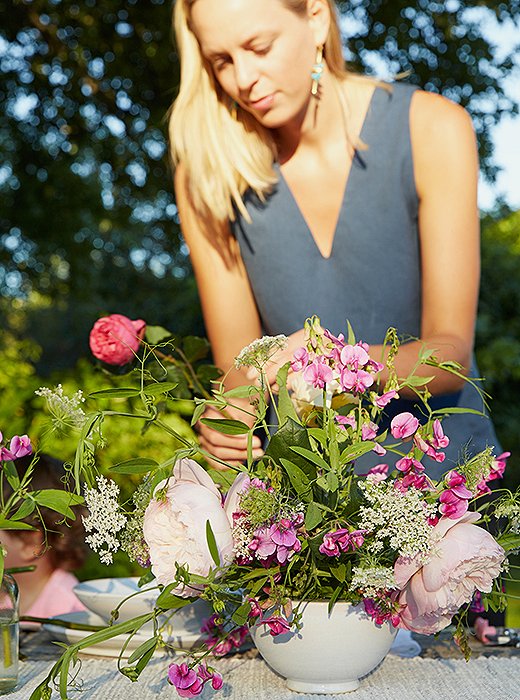
A flower pot by Nell holds a surprising number of flowers. I supplemented what was in the garden with some garden roses from Flowers on Chestnut, a shop I’d worked in one summer while in college. It always keeps a stash of garden roses in the back.
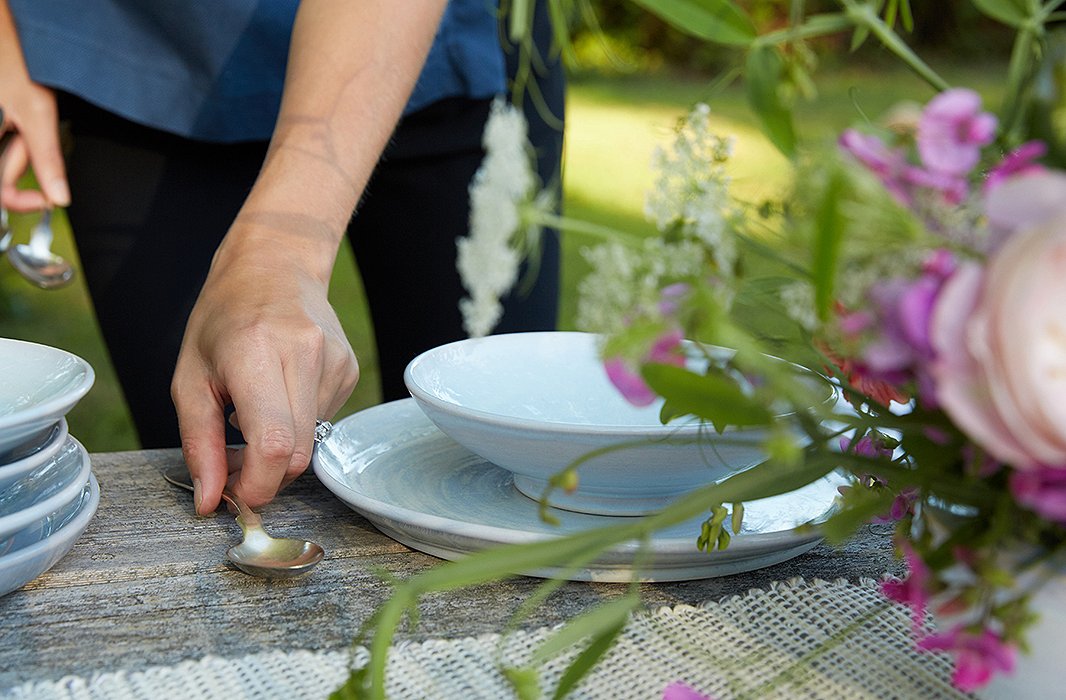
I used plates and shallow bowls, all made by Nell. Once the gazpacho was finished, we cleared those and served fish on the plate.
My Own Take on Open House
As for the vibe, I wanted to keep it on the loose side—no place cards, no shoes necessary. And really, this was just family and a few dear friends, which took any residual pressure off entirely.
Thumbing through Sarah Leah Chase, I’d found her idea of an open-house gathering. To paraphrase her, if you master great food, you’ll end up with lots of interesting people around your table. What a good argument for perfecting a summer repertoire. And don’t make people feel that have to be there at 7 p.m. on the dot, dressed for dinner. Let them feel they can drop in, even for a drink en route to somewhere else, or come early and help you shuck corn. Keep extra bowls and spoons nearby.

You sense the superior balance of this gazpacho before the first taste—the diced bits swim happily in purée. I forgot to finish the whole thing with a swirl of olive oil, which would have given it even more glow.
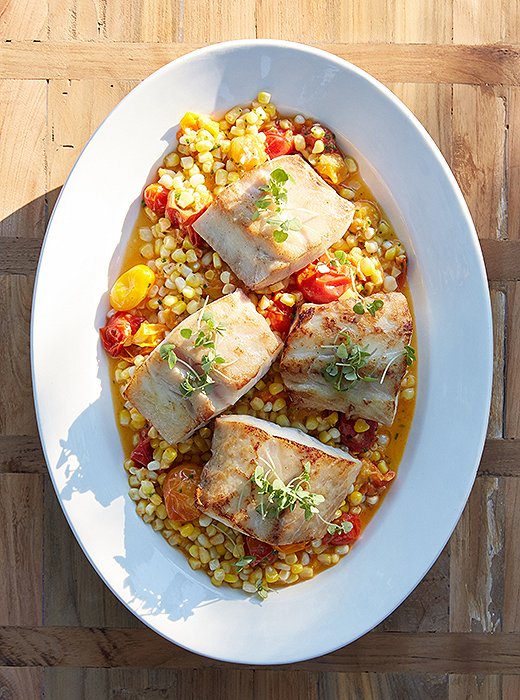
The fish sitting prettily on its summery bed. Not a kernel was left here.
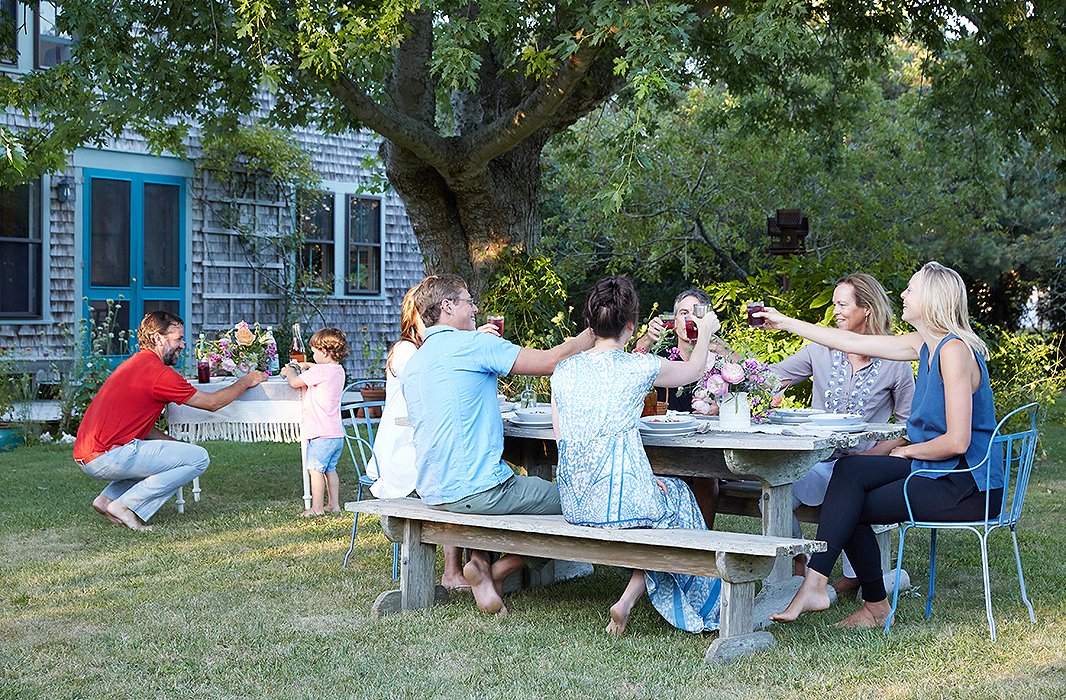
My husband, Phillip, and our son, Henry, have their own private toast at the drinks table.
Sending Off Summer
I like this feeling of sending off summer with a last outdoor dinner. Thirty miles out at sea, I think you become more intimate with the elements—wind shifts, the coziness of fog, the excited anticipation of storms. After I went to boarding school, I loved calling home and getting my dad’s report. When I asked how things were, he’d always begin with the current wind direction: “Well, it’s mostly been blowing out of the north.”
If you live on the island, the end of summer isn’t entirely sad. Every islander has a soft spot for September—it’s when the beaches and streets are returned to those who live there year-round. The sun stays warm, but there’s a subtle wind shift, a drop-off into a welcome autumn chill. You can almost pinpoint the moment it happens. It’s often the same moment when the population drops from its summer peak of something like 60,000 to its year-round count of around 10,000. As a family friend described it once, “The day after Labor Day, the island is like a bathtub with the plug pulled out. The people all drain away.”
As for me, I am carrying the blueberry-basil syrup back to New York and can’t wait to stir up fall cocktails.
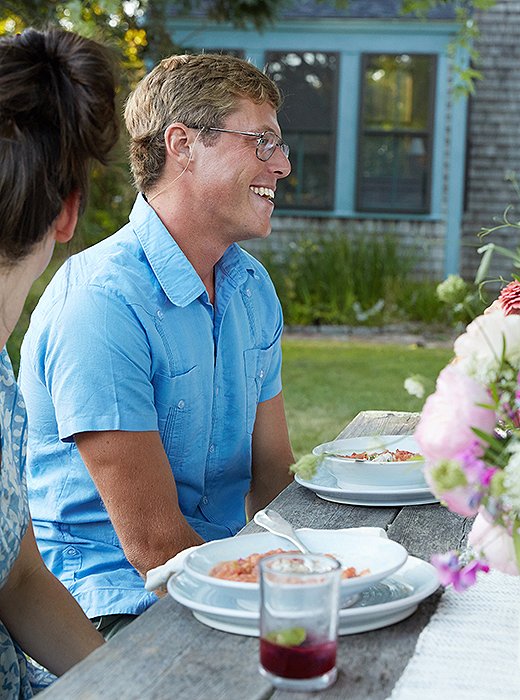
My brother Oliver. I love being back on the island at the same time as my two brothers.
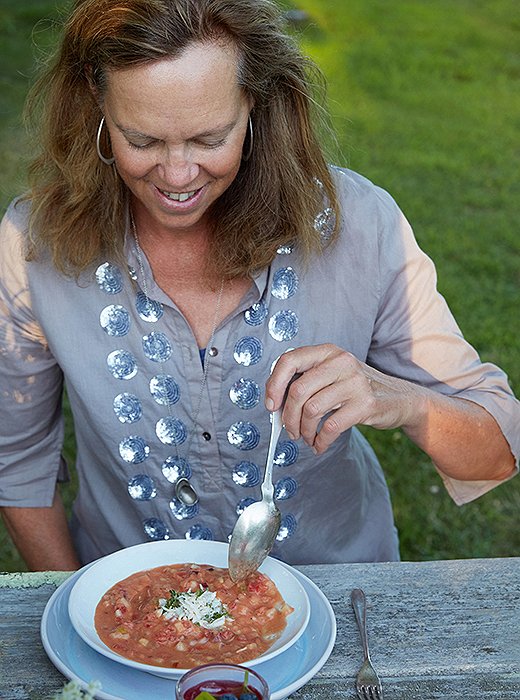
My mom tucks into the crabmeat garnish.

A childhood friend, Caitlin, now lives down the road. She and her husband came when their little William woke up from his snooze.
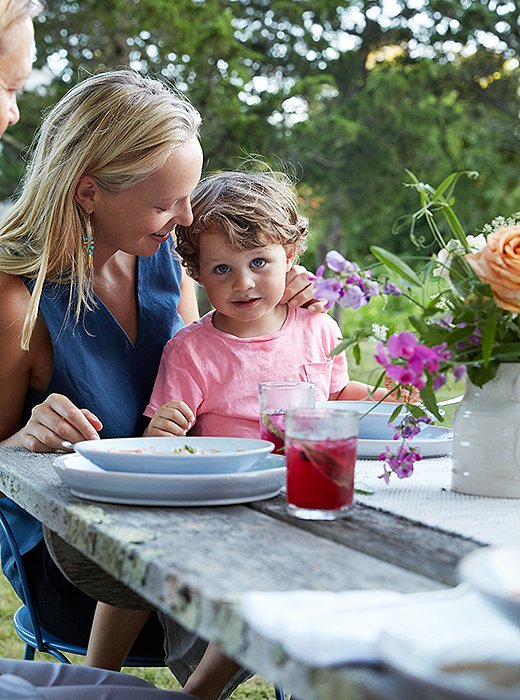
Nothing like hosting a dinner well before the toddler bedtime hour so that everyone can join in. Henry loved his first proper outdoor dinner.
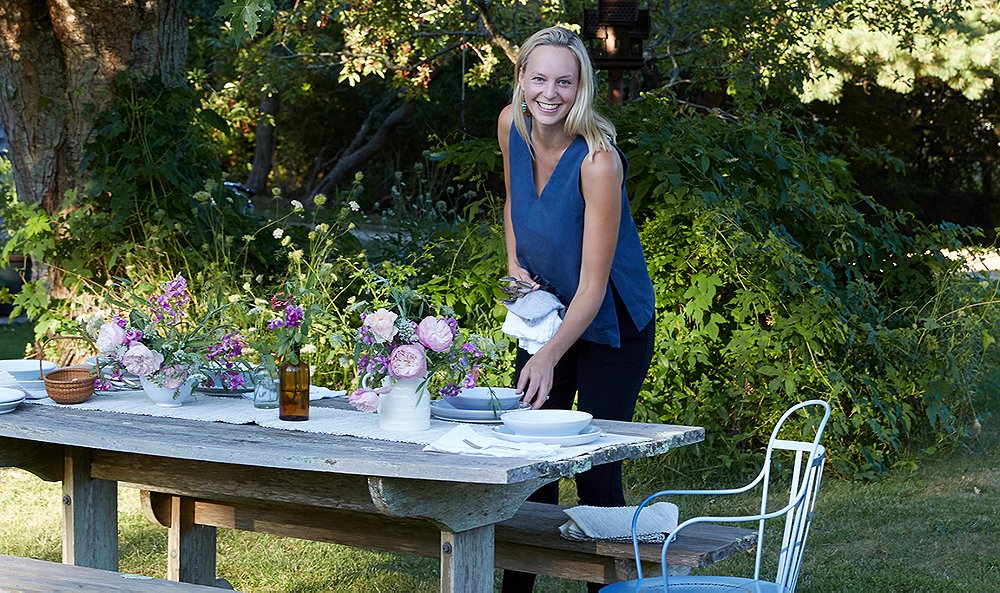
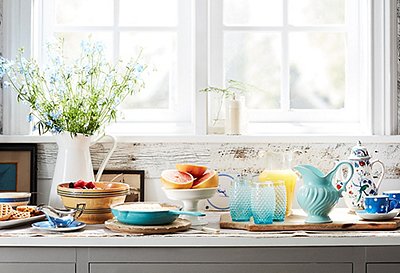
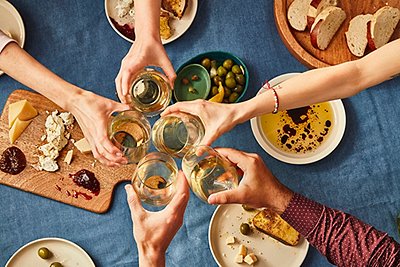
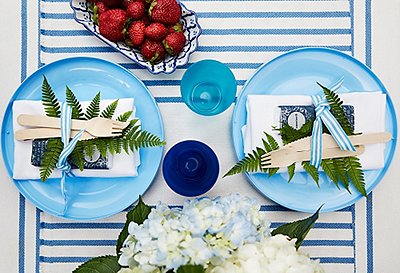



Join the Discussion